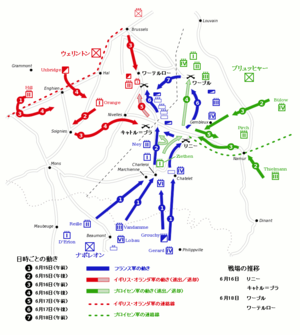Battle of Quatre Bras
|
|
Template:Battlebox The Battle of Quatre Bras was fought between contingents of the Anglo-allied army and the left wing of the French Army on June 16 1815, near the crossroads of Quatre Bras, in Belgium.
| Contents |
Prelude
"Napoleon has humbugged me, he has gained twenty-four hours march on me" – the Duke of Wellington
Netherlands troops had fought a battle at Quatre-Bras and had done so on their own initiative, chosing not to carry out Wellington's orders to move all their troops on Nivelles. These orders would have kept the crossroads unguarded.
The crossroads of Quatre-Bras was of strategic importance because the side which controlled it could move south-eastward along the Nivelles-Namur road towards the French and Prussian armies at the Battle of Ligny. If Wellington's Anglo-allied army could combine with the Prussians commanded by Gebhard von Blücher, the combined force would be larger than Napoleon's. If one or more of Ney's French army corps could strike the Prussians in the flank while Napoleon attacked them frontally, they could be not just defeated but annihilated. Napoleon's strategy had been to cross the border into Belgium without alerting the allies and to defeat the Prussians before turning on the Anglo-allied army. He was initially very successful in this move.
The Fighters
At the beginning of the battle Marshal Michel Ney, with the left wing of the Armee du Nord, faced a force of some 8,000 Netherlands infantry and 16 guns under the command of the Prince of Orange, thinly deployed south of the crossroads of Quatre Bras. As the day continued Anglo-allied troop numbers increased as more units converged on Quatre Bras. Also at 3 o'clock the Duke of Wellington appeared on the field. The French force numbered 18,000 including 2,000 cavalry and 32 guns. During the day the French force would grow to 24,000.
The Ground
The battle was fought around the crossroads of Quatre-Bras, a small hamlet with only four houses. This crossroads marked the junction between the Charleroi-Brussels Road and the Nivelles-Namur Road.
To the South-West of the junction was the Bossu wood. South of the wood were the farms Petit- and Grand-Pierrepoint. South of the crossroads the ground fell away to the Gemioncourt farm, which lay next to a small stream in the valley. The ground then rose again to the south. North of Quatre-Bras the ground dropped into a reverse slope.
The Battle
The Battle Starts
The French attack began around noon. Ney formed a massed battery of 22 guns and started bombarding the allied positions. Swarms of skirmishers preceded the French columns as they attacked. The picket Netherlands line greeted them with musketvolleys, but were forced to retreat by numbers. The Nassauers of Saxe-Weimar retreated to Grand-Pierrepont farm and the Dutch troops of van Bijlandt to Gemoincourt.
After a while the fresh division of Jerome Bonaparte arrived on the scene. They were sent against Grand-Pierrepont. The Nassauers were forced to abandon the farm and were driven into the Bossu wood. There they fought from tree to tree to slow the French advance. At Gemoincourt the Netherlands troops were a thorn in the eyes of the French. One of the defending battalions, the 5th militia, lost 62% of its original strength that day. The Dutch lost and retook the farm twice, but eventually lost it.
Around 1400 hours, Ney started his assault on Quatre-Bras. Using a combined assault of infantry, artillery, and cavalry, Ney was able to push the Netherlands troops all way back to Quatre-Bras. The situation became desperate. The pressure of three infantry divisions and a cavalry brigade was too much for the Netherlands 2nd division.
Thankfully for the allies at 1500, reinforcements came in: Picton's 5th British/Hannoverian infantry division and van Merlen's 2nd Netherlands cavalry brigade. The duke of Wellington came back from his meeting with Blücher. Van Merlen's brigade charged the French cavalry but were thrown back. However, this gave the battered Netherlands infantry time to regroup themselves. Also British infantry was ordered to form a line. However when the Netherlands cavalry brigade disengaged and retired to friendly lines they were being shot at by Scottish infantry because their uniforms looked like the French uniforms of the Chasseurs á Cheval.
At 1600 hours, Ney received Napoleon's order to attack vigourously. He sent an order to his II corps to attack with more force and for his I corps to hurry up. Ney also was reinforced by Kellermann's heavy cavalry.
The Battle Continues
Unfortunately for Ney, his requested reinforcements (I corps) were marching towards Napoleon now engaged at the Battle of Ligny, and Ney was left without the infantry needed to punch through the allied line. At 1615 hours, French mixed forces advanced almost all the way to the crossroads. The British 42nd, 44th and 92nd regiments held up against the infantry - and then were mauled by Kellermann's cuirassiers. However, they were driven back by allied musketry and cavalry. Another front was more successful for Ney. Jerome Bonaparte, Napoleon's youngest brother, drove the Allies out of the Bossu Wood. Just then, three Allied brigades came and drove the French back south and to the original positions. Notable is that the 1st regiment of the British Guard was caught by surprise by Piré's French lancers just near Pierrepont and lost 500 men. They retired into the wood.
Due to confusion on the part of its commander as to which battle to join, Ney's I corps wound up fighting in neither.
Conclusion
The battle cost Ney 4000 men to Wellington's 4800. Although a tactical victory for the Anglo-allies, it was a strategic deadlock because neither side was able to send forces to affect the outcome between the French and Prussian forces at the Battle of Ligny. Wellington's Anglo-allied army, upon learning of the Prussian defeat, was forced to retreat northward but parallel to the retreating Prussians. Napoleon chose to follow Wellington with the bulk of his forces and two days later met his destiny at Waterloo.

